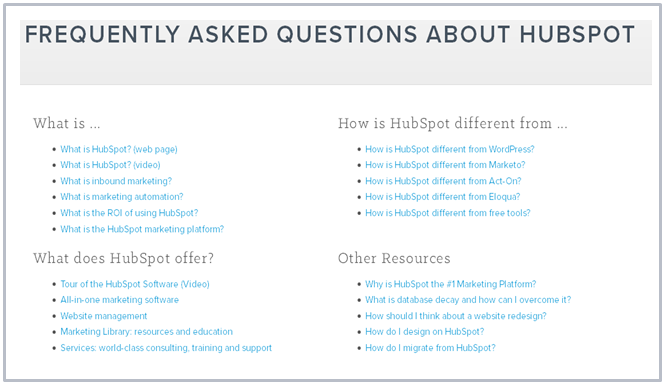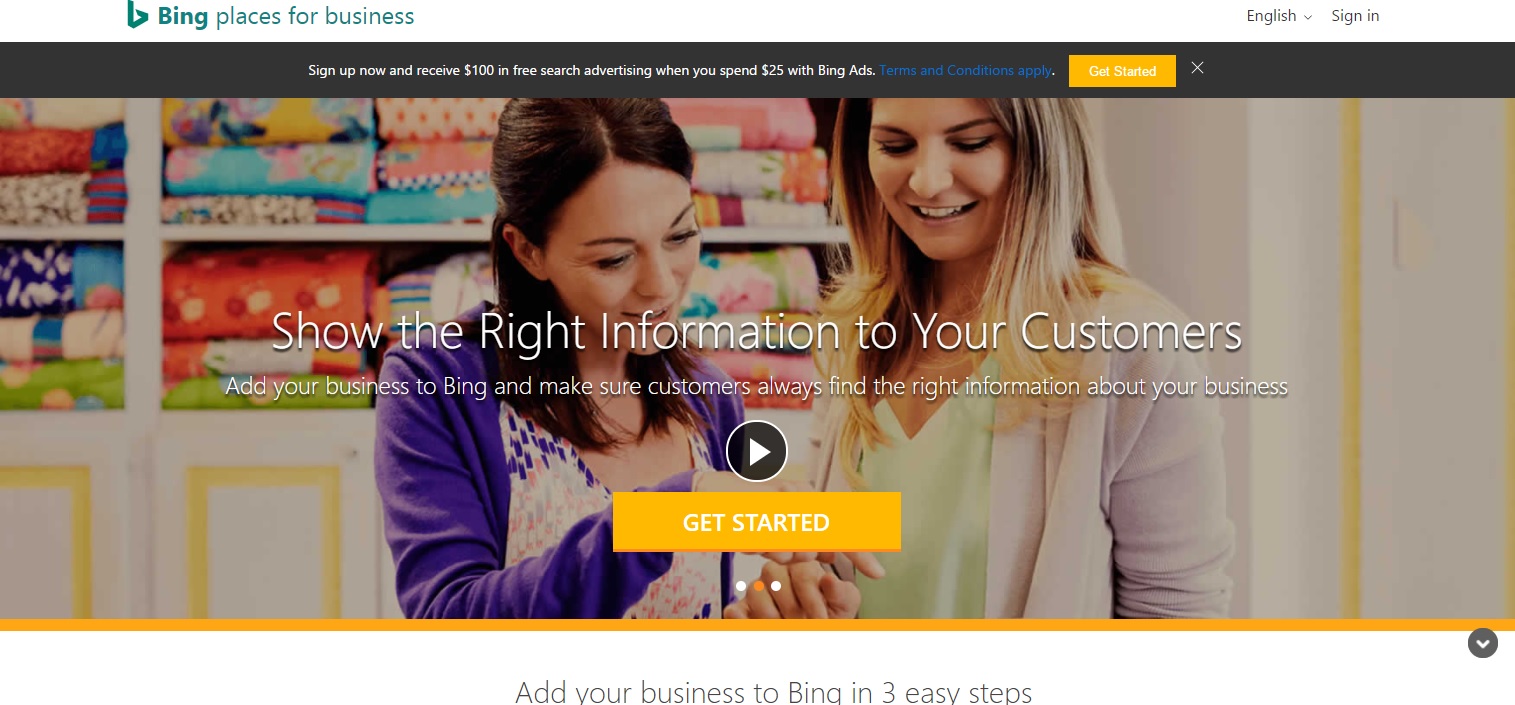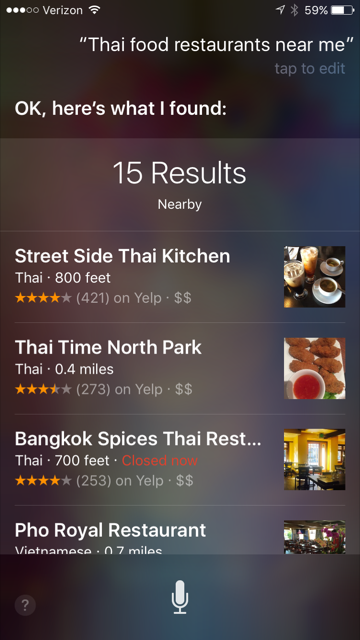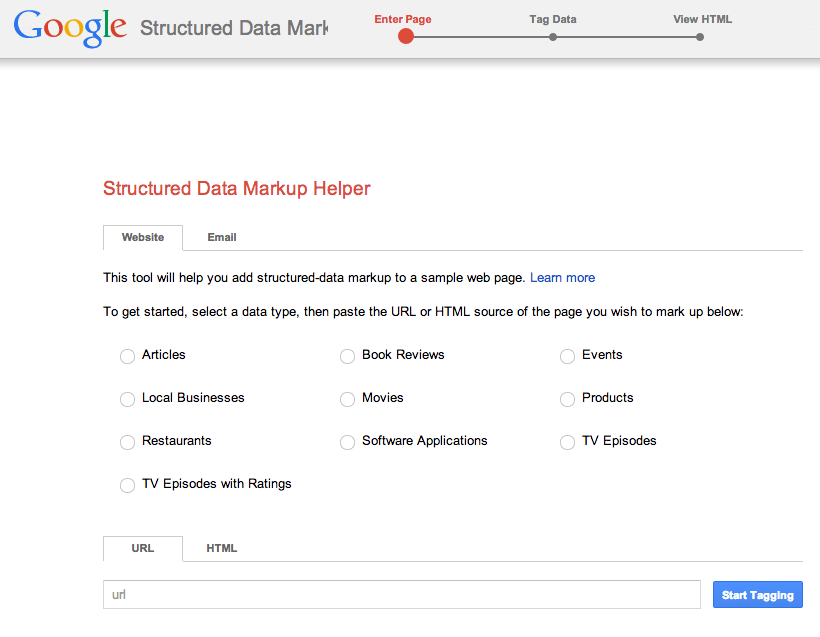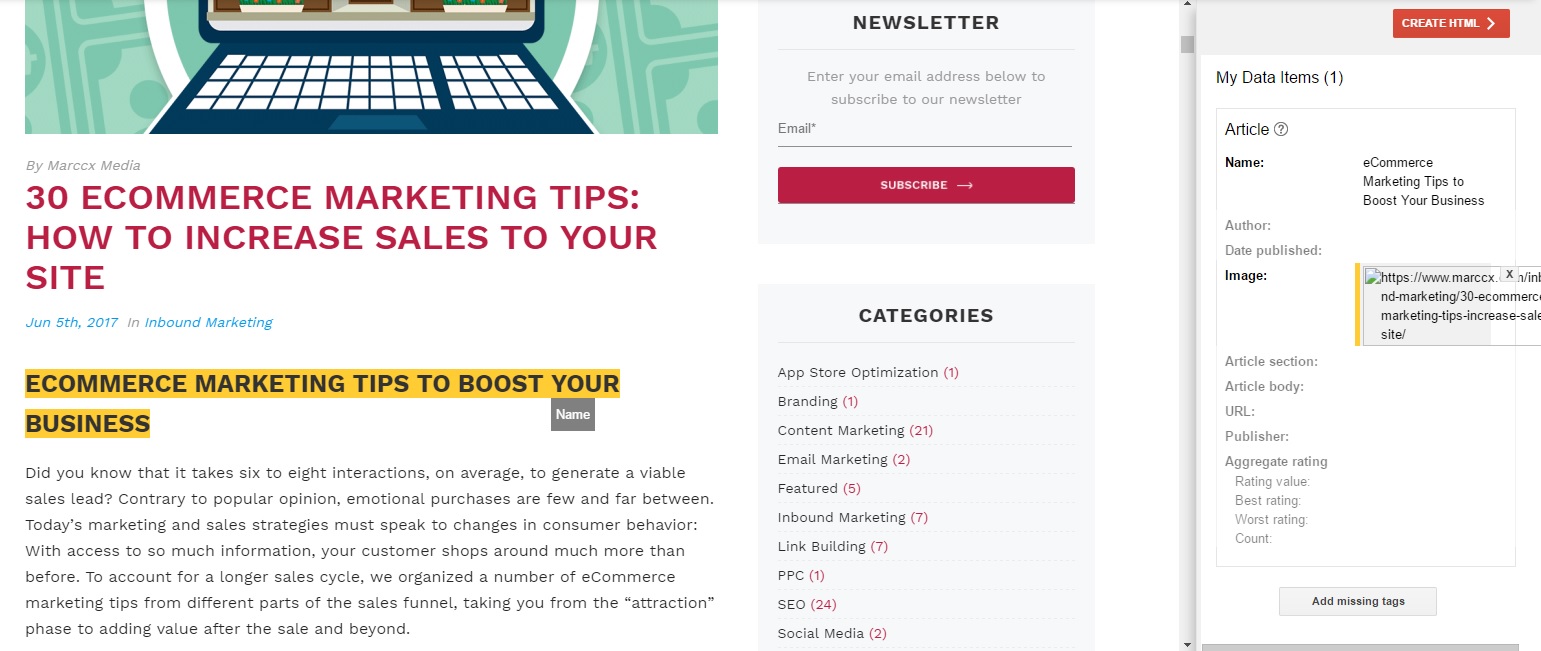How To Optimize Your Business For Voice Search Dominance
Remember when “Hey Siri” used to be a seldomly used refrain? It was the kind of thing you might say in a joking manner around friends, but never as a serious way to conduct an online search. Well it’s 2017, and times have certainly changed. Voice search is now about as commonplace as frozen yogurt, and we’re seeing new companies release their own versions of these ‘digital assistants’ on a regular basis. The demand is clearly growing. Google states that 20 percent of mobile queries are voice searches, and this number has grown exponentially over the past six months.
Don’t believe it? Take a peek at this graph courtesy of Search Engine Land:
The data is plain as day; voice search is here to stay. So the question becomes, how can you harness this burgeoning technology and turn it into a net positive for your business? The key isn’t in waiting for voice search to optimize itself to your needs. It won’t. The key is to proactively optimize your content in a way that takes full advantage of voice searches’ unique way of performing searches.
So let’s elaborate on what we mean by “unique.”
Having a Conversation
What do you type into a traditional search query? Probably a topic composed of 2-4 keywords. Usually something along the lines of, “healthiest dog foods,” “at home exercises,” or if you’re really bored, “sunset time Costa Rica.” Traditional searches were always about brevity, hence the reason why short-tail keywords (searches between 1-3 words) are more expensive to bid on than long-tail keywords (searches between 4-6 words). Simply put, people tend to type shorter phrases. But voice searches don’t involve typing, they involve a conversation, or so people think. Even though they aren’t speaking to a regular human being, the presence of a voice makes users naturally slide into a conversational tone.
Jim Glass of the Massachusetts Institute of Technology’s Spoken Language Systems Group, says “if you make the interaction more like human-human interaction, humans might not have to think as hard about how to express themselves, because the computer would be behaving in ways a human would.” This could result in much more honest, direct search queries, where people are asking longer questions, but the content is more precise.
For marketers, these long-tail, spoken keywords could result in much higher quality, and better targeted leads coming to your website. Now it’s time to organize a plan of attack so that we can collect this pool of potential customers, all the while boosting our brand’s presence. We’ve discussed WHAT voice search is all about, at it’s core, now let’s get into the HOW so you can reap its benefits for your business.
Mastering Your SEO
We are going to spend a lot of time in this piece talking about SEO strategy, largely centered around long-tail keywords. What are long-tail keywords? They consist of anywhere between three and six words, and they get very specific in the way they address topics.
Not to sound like a broken record or anything, but SEO is still very important to your website, and the way that your site is indexed across search engines—including voice search. This fundamental concept doesn’t change when we talk about voice search; however, the way it’s implemented does. Here’s how you should approach your SEO strategy while catering to the demands of voice search.
Keywords
Yes, keywords are still the fundamental building blocks for your website and overall SEO strategy, but they take on a different form when optimizing for a voice search. Like we said before, instead of focusing on short, abrupt keywords, like “bike parts,” or “yoga mats,” we need to think in terms of long-tail keywords like, “where do i get yoga mats,” or “how much do bike parts costs?”
For example, let’s say you’re a travel brand that offers vacation packages to South America.
When formulating keyword ideas for your site, you’ll come across inspirations that may include the following: South American travel, airfare to Brazil, South American vacation, flights to Argentina, Rio hotel packages.
These could all be great keyword ideas, and they could even become their own pages on your site, but would these phrases ever be asked by people using a voice search? Probably not. In this example, your target customers would say things like: “Hey Siri, show me the best travel packages to South America,” or, “Hey Alexa, find me cheap airfare to Brazil.” When selecting keywords for voice search, you must think in terms of your customers’ most likely to ask questions. Make a list of these, adding them to your long-tail keywords. Maybe even label them as REALLY long-tail keywords if that helps.
At first it might be hard to figure out the best long-tail phrases that can mesh with your voice searches, but there’s a simple trick to help you along. Just sit in a quiet room and vocalize the questions to yourself, thinking about such rudimentary things as, “what problems are my customers wanting resolved?” Or even better, “how would they ask for my assistance if they walked into my store?”
Understanding the questions that customers are asking in voice search is not only helpful to your overall keyword research, but it helps you keep tabs on the competition.
Ask Siri Your Keywords
Once you’ve built an excel spreadsheet full of fantastic keyword possibilities, you can narrow them down further by performing your own voice searches. Simply pick up your iPhone, or Amazon Echo, or whatever device you’re using for voice, and ask away. You’ll be doing this as a way of scouting the competition, learning which brands register for certain phrases. Pay attention to the brands that pop up first.
Let’s take our South American vacation example. Here’s what appears when I ask Siri about hotels in Rio de Janeiro:
Because I used the word “cheap” in my query, Siri sorted my results by price.
Let’s try a differently worded question. How about someone looking for suggestions on how to fix a hole in their basement?
Rather than bringing up a list of Yelp reviews or service prices, Siri pulled long-form content off the web. It’s clear that she targeted the keywords, “fix hole,” and “hole in basement,” among others related to this specific inquiry. It’s also important to note that the results are from a Bing search, not Google. Bing is Siri’s default search engine, unless you use the word “Google” before asking for a particular search.
Why is this important? Although Bing and Google are pretty darn similar search engines, there can sometimes be differences in keyword favorability.
Consult your Keyword Planner on both platforms to make note of their average searches. For example, here’s what we get when we type “basement waterproofing” into the Google AdWords Keyword Planner:
You’ll notice it has almost 15,000 searches per month and it’s a highly competitive keyword. Below it, we also see other similar keywords that are pretty competitive too, and “waterproofing basement” has only a third of the monthly search total.
Contrast those numbers to Bing’s results:
“Basement waterproofing” has a third of the results on Bing as it has on Google, but look at the other keyword suggestions. In AdWords, the next suggested keywords were “foundation repair,” and “waterproofing basement,” but Bing seems to go right into the products and services route. After “waterproofing basement,” Bing lists “basement waterproofing companies,” and “basement waterproofing products.” Since these keyword suggestions lists go according to the metric “average monthly search volume,” we know that Bing users are more likely to search directly for plumbing companies to help with their problems rather than searching up DIY solutions.
However, remember how I worded the voice search above: “I need some supplies to fix a hole in my basement.” The word ‘supplies’ undoubtedly triggered a search for items one can use to fix a hole in their basement.
The first result was from a Washington Post article about how to fix hole’s in your home’s concrete foundation, but the second result is what intrigues me. Take a look:
It’s from 2008, from a forum called DIY Chatroom.
This is was literally written by an anonymous internet user who just happen to answer the explicit question I asked, almost word for word. Clearly, Siri scoured the web for the most precisely keyword-ed answer she could find, and voila! We have the answer we needed.
What does this tell us about the way we should optimize our content for voice search? It says that choosing our keywords is important, but it’s more important that we’re addressing a customer’s pain point by answering their question wholey. And for this, phrasing is everything.
Measure Intent
When marketers complain about long-tail keywords not working for them, it’s often due to a lack of understanding regarding intent.
Short-tail keywords are only a couple of words in length, so it’s much harder to gauge a customer’s search intent from them. For example, the phrase “flat screen tv” is very broad. We don’t know what size TV they want, nor do we know their price points. Heck, we technically don’t even know whether they want to purchase one, or just look up some specs because maybe they’re a technology buff. In contrast, if we take a long-tail phrase like, “what is the best flat screen tv for less than five hundred bucks,” we know that we’ll get a much smaller quantity of searchers but they’ll have a much higher value to us.
Part of measuring intent is understanding how to use filler words—which can be pronouns, prepositions, or lots of “the”s. When people perform a voice search, they make their questions personal. “What is the fastest route to my office?” “What simple hacks will make my life easier?” Our goal is to understand this intent and address it within our content.
Determine Proper Adverbs
Because voice search is so precise to the way a user phrases their question, we have to remind ourselves of an English term we learned in fourth grade—adverbs.
That’s right! It’s time to reflect on the who, what , where, when, why, and how. These terms are used to start any question, so it’s our job to determine which ones will be most likely used by customers using voice search.
According to Moz, “who” is the most common intro word for a voice search query, which indicates that many people are asking Siri things like, “who built the Great Wall of China?” Or, “who is Luke’s real father?”
A distant second to “who,” is the word “how,” meaning that people are also using voice search to try and learn things on their own. They want that actionable solution that they can enact right away, which makes it your job to give it to them.
By empowering your consumer with answers on “how” to do things, or fix things, or make good things happen in their lives, you are handing them the gift of knowledge. It’s something that everyone craves, and can be used as a highly effective tactic to draw people into your brand.
Once you’ve gotten them into your funnel by dropping them some “free” knowledge, it’s time to begin turning them into paid buyers.
Let’s revisit the example about trying to fix a hole in our basement. You’ll notice the third listing from that Siri voice search was from an article on FamilyHandyman.com. This is a site chock full of DIY-related articles, helping people solve problems like a “hole in the basement.”
Here’s the article that Siri takes us to:
“Drying a Wet Basement” walks you through the process of sealing and repairing your basement area to prevent damage from rainwater and other hazards. The reason this article was picked near the top of our Siri results is clear. The website has been around for a long time, has accrued a ton of domain authority, and it’s tied to a reputable magazine of the same name.
In fact, FamilyHandyman.com capitalizes on its fantastic SEO by eventually pushing their high ticket offer to consumers—an annual magazine subscription. It’s pretty smart.
And to think, this is all started by the website answering a simple question for their prospective customers.
What if you could answer questions on a much larger scale? Just think of how many leads you could generate through voice search. Well, this idea has existing in various forms for the entire lifespan of the internet…
FAQs
By this time, you should have compiled a nice list of long-tail keyword phrases based on questions your consumers might ask. So now, it’s time to build a web page that organizes these questions and provides answers to them—but most importantly, one that can help you rise up the voice search ranks.
Building the right FAQ page isn’t rocket science, but it needs to be built with the user in mind. Let’s look at an example:
Digital marketing giant Hubspot has one of the simplest, yet well-organized FAQ pages you’ll come across.
Notice how every question is categorized? This helps your SEO rating, because lest we forget that ease of navigation is a ranking factor.
Of course when it comes to creating questions, you don’t want to create any duplicates. It’s an SEO ploy that simply won’t work. All it does is delegitimize your website, and hurt your brand.
For example, if a pool cleaning service has the question: “how often should I replace my pool filter?” They shouldn’t also have a question like, “how often can I replace my pool filter?” Or even worse, “how often should I replace my pool filters?”—the plural form of the first question. If all you’re doing is changing a word here and there, that isn’t good enough.
Nope, changing a few keywords from singular to plural will not enshrine you in SEO heaven. In fact, it could knock you off the rankings altogether, which is especially bad for your voice search potential—since voice search only displays the very top results.
You want to offer unique content within every question. In the pool service example, go from “how often should I replace my pool filter?” to “what tools do I need to replace my pool filter?” It’s okay to be specific in your FAQs, but don’t replicate questions 100%.
Think of your FAQs as your in-store help desk. Approach each question as if the customer is asking you face to face. Then craft your answers in a detailed way that provides lots of value, and gives Siri no other option but to grant you a top spot in the results.
Of course your FAQs should address issues related to your specific products. However, there’s no harm in answering questions about general issues within your niche. Going back to our pool cleaning example—for every question that reads, “what are our business hours?” you can present answers to non-brand related questions like, “how often should I add chlorine into my pool?”
The result is twofold: a) takes care of the really important product-related questions and concerns, and b) improves your SEO and voice search ranking.
Local SEO
So now you understand which long-tail keywords should govern your SEO strategy, you’ve optimized them to measure customer intent, and you’ve organized them into blog posts and FAQs to rank among the major voice search results. Those are all really important steps in getting you started, but now it’s time to address the local angle—because as it turns out, voice searches are a highly lucrative tool for local businesses.
40% of voice searches have local intent—that’s nearly 1 out of every 2. Sure, on-site SEO is important, but that alone won’t help you dominate local voice searches. Here’s what you need to do to truly own the local space.
Claim Your Business
If you’ve yet to claim your business as a Google My Business listing, do it now. This effectively tells Google that your business exists and points customers to your website, phone number, and physical location. Then, we someone in your area performs a voice search for your type of business, viola! Your business listing will appear.
Here’s how easy it is to create a Google My Business listing.
First you’ll go to the Google Business website:
Click “Start Now” and fill in your business’s information:
Click “Submit” and your business is made official in the eyes of Google. You can do the same thing on Bing.
When customers are near your restaurant and search for “thai food restaurants near me” this will come up:
It’s crucial that you get your business registered, but it’s also important that you seek out reviews. Case in point—here’s what happens when we rephrase our voice search to “best Thai food restaurants.”
Notice a difference? The results are reordered according to the most positive Yelp reviews. So yes, reviews matter.
Why Reviews Matter
For your local SEO to thrive, you must seek out as many positive reviews as you can. Like we showed up above, voice search business results automatically display your star rating based on the average review score. The lower your rating—and total number of reviews—the lower your overall score. You could make the best Thai food in town, but without testimonials it doesn’t matter.
For local business websites, this is perhaps the single most important booster of ranking, especially with voice searches on the rise. Think about it.
Let’s say a husband and wife are driving through town, looking for somewhere to eat brunch; instead of typing a search on their phone, they are more than likely going to do a voice search. Studies show that 61% of the time the reason for a voice search is when someone’s hands or vision are occupied.
When folks are in the car, they want immediacy. Inputting their search query by hand is simply not the fastest option.
So now that we understand the importance of positive reviews, HOW do we get them?
Collecting Reviews
The easiest, and most automated method is via email. But instead of asking them to hop straight over to Yelp and unleash their opinion, it’s best to perform a pre-screening. In other words, have them fill out a short, simple survey about their experience with your business, and if all goes well, you can then ask for a public review—i.e. hopping over to Yelp.
We realize this is a lot easier for food and hospitality brands than it is for an auto repair shop or an electrician. So another way to collect reviews is by asking your customers in person. According to a Local Consumer Review Survey performed by BrightLocal, 70% of consumers will leave a business review when asked.
The bottom line is, if they liked your service—and hopefully liked YOU too—they will be more than happy to extend a bit of charity your way.
And if they ask why, just say Siri wants them to do it.
Video Content
Before you say, “how on earth do videos factor into voice search?” Hear us out.
By the end of 2017, video content will represent nearly 75% of ALL internet traffic. Do you really think the minds behind Google Assistant, Siri, and Alexa will ignore this fact? Absolutely not. In fact, they’re already starting to include videos in voice search.
For example, when you ask “how to fix a couch,” you’ll get this:
But when you scroll down a bit, you’ll see three video options.
Pretty cool, right? We’re not saying this should be your first priority as a brand whose optimizing for voice search, but an authoritative video never hurts you. An engaging video can place you as a thought leader and help you generate leads for your brand.
Just like every other form of SEO, video rankings are undergoing a major transformation in the way they’re determined. In addition to recognizing your title, description and tags, Google now factors in your voice within the video itself. It monitors patterns of speech and can boost your ranking if a person in the video mentions specific keyword phrases. Crazy stuff!
Technical SEO
SEO isn’t all about the glamor factor. As much as we wish we could just produce high-quality content all day with excellent keywords sprinkled about, it’s just not that simple. A large part of SEO dominance, especially when it comes to mobile and voice search optimization, includes making necessary backend tweaks that tell search engines how to interact with your site.
Here are the technical SEO elements that many marketers overlook, or simply forget about. But they can have surprisingly positive effects on your rankings.
Schema Markup
One of the most underutilized technical SEO hacks is that of schema markup. Simply put, this is a piece of code used to inform search engines about the context of your pages. Many times search engines will get confused when certain keywords could have multiple meanings. For example, if you operate a French restaurant called “Claire de Lune,” Google might confuse it with search queries about the musical piece, “Claire de Lune.” By applying schema markup for your restaurant, you’d be able to tell Google that you’re not actually a 19th century composer.
Here’s what Google’s scheme markup interface looks like.
As you can see there are options for just about any website type. Once you select the one that applies to you, just enter your URL and click “Start Tagging.”
If you’re using schema markup on your blog content, you’ll choose “article.” Then following page lets you highlight the areas of your content relating to the markup—name of article, author’s name, image, article body, URL, etc.
After clicking “Create HTML” you can import the newly created code into your CMS and there you go!
We advise you follow the same process for Bing and Yahoo!
Studies indicate that sites using schema markup see around a 3-4 spot boost on SERPs. It might not sound THAT significant but when we’re talking about the limited space on a voice search, any boost is massive.
Rich Snippets
Like schema markup, rich snippets are used to differentiate your pages on SERPs. They do this by placing snippets of text around your URL.
They allow you to include additional product information, like pricing, the status of your stock, and most importantly your star ratings.
Although you might not directly notice these snippets when conducting a voice search, this bit of extra microdata helps search engines understand your site.
XML Sitemaps
Lastly, be sure to provide voice search with a blueprint to your website using XML sitemaps. This is a list of your site’s pages that Google will use to understand the layout of your site.
If you’re using WordPress and the Yoast SEO plugin, you can easily retrieve these sitemaps and input them into search engines.
Just another bit of crucial microdata that can give you a leg up on competitors in your niche. The best part about this “technical SEO” advice? You don’t have to be a developer to make these changes a reality. They can be completed by you in just a few minutes’ time.
Voice Search Dominance is Achieved Through Mobile Optimization
It’s not rocket science—the rise in voice search is happening alongside the rise in mobile usage. As more consumers ditch their desktops in favor of phones and tablets, there will be more demand for Siri, Cortana, and Alexa to solve all of their imminent problems. Everything from wanting to know how much cake batter to use, to trying to fix that hole in our basement. For marketers this excites us. It means we aren’t too far away from consumers making all important purchases through voice.
Until then, it’s important to focus our brand optimization efforts on mobile since it’s the gateway to voice search. If our site is optimized for mobile then the SEO gods will smile. In turn, this will improve our voice search dominance.


